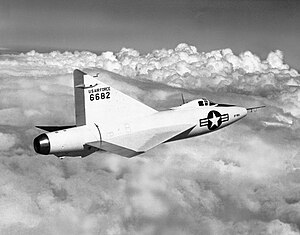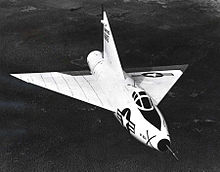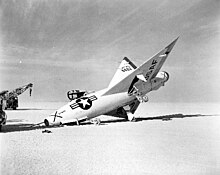This is an old revision of this page, as edited by Cydebot (talk | contribs) at 07:54, 8 May 2019 (Robot - Moving category United States experimental aircraft 1940–1949 to Category:1940s United States experimental aircraft per CFD at Misplaced Pages:Categories for discussion/Log/2019 April 19.). The present address (URL) is a permanent link to this revision, which may differ significantly from the current revision.
Revision as of 07:54, 8 May 2019 by Cydebot (talk | contribs) (Robot - Moving category United States experimental aircraft 1940–1949 to Category:1940s United States experimental aircraft per CFD at Misplaced Pages:Categories for discussion/Log/2019 April 19.)(diff) ← Previous revision | Latest revision (diff) | Newer revision → (diff)| XF-92A | |
|---|---|

| |
| A photo of the Convair XF-92A in flight | |
| Role | Interceptor aircraftType of aircraft |
| Manufacturer | Convair |
| First flight | 18 September 1948 |
| Status | Canceled |
| Primary user | United States Air Force |
| Number built | 1 |
| Variants | Convair F-102 Delta Dagger |
The Convair XF-92 (originally designated XP-92) was an early American delta wing aircraft. Originally conceived as a point-defence interceptor, the design was later used purely for experimental purposes. However, it led Convair to use the delta-wing on a number of designs, including the F-102 Delta Dagger, F-106 Delta Dart, B-58 Hustler, the US Navy's F2Y Sea Dart as well as the VTOL FY Pogo.
Design and development
Early work


Prior to August 1945, the Vultee Division of Consolidated-Vultee looked at the possibility of a swept-wing aircraft powered by a ducted rocket. Years earlier, the company had performed designs which involved liquid-cooled radiator engines. With this design, fuel would be added to the heat produced by small rocket engines in the duct, creating a "pseudo-ramjet".
In August 1945, the United States Army Air Forces (USAAF), soon to be renamed the United States Air Force, issued a proposal for a supersonic interceptor capable of 700 mph (1,100 km/h) speeds and reaching an altitude of 50,000 feet (15,000 m) in four minutes. Several companies responded, among which was Consolidated-Vultee, which submitted its design on 13 October 1945. This design featured swept wings and V-tails, as well as a powerful propulsion system. Besides the ducted rocket, four 1,200 pounds-force (5.3 kN) rockets were positioned at the exhaust nozzle, along with the 1,560 pounds-force (6.9 kN) 19XB turbojet produced by Westinghouse.
A proposal by Consolidated Vultee (later Convair) was accepted in May 1946, with a proposal for a ramjet-powered aircraft, with a 45° swept wing under USAAF Air Materiel Command Secret Project MX-813. However, wind tunnel testing demonstrated a number of problems with this design.
Switch to delta
As part of Operation Paperclip and similar efforts, Alexander Lippisch's DM1 research glider had been completed and shipped to the National Advisory Committee for Aeronautics (NACA) Langley Research Center, along with considerable German research on swept wings and delta wings. The DM1 was the first in a planned series of four similar testbed aircraft, each one exploring faster speeds. The DM1 was built to test low-speed handling only.
At Langley, the thick-section airfoils of the DM1 were found to generate considerable drag at transonic speeds, and a series of experiments followed to try to explore these issues. Two lines of study were considered; sharp fillets were added to the wing's leading edge, and the vertical stabilizer was significantly shrunken in size, thinned, and moved rearward. This left considerable room in front of the stabilizer, where a conventional cockpit was fitted. During these tests, the tendency for the wings to generate large vortices at high angles of attack was noticed, but the significance of this was not exploited until many years later.
Langley passed along the delta wing information to Convair designers Adolph Burstein, the assistant chief engineer of the San Diego Division, and Ralph Shick, chief of aerodynamic research. The two were initially sceptical of the delta wing, but Shick flew to meet Lippisch at Wright-Patterson Air Force Base and returned to Convair's Downey plant convinced this was the way to move forward.
Convair's mixed propulsion system required a very large air duct to the engine, which supplied not only the jet engine with air, but acted as a supply to the rockets to produce thrust augmentation. This left nowhere to put a traditional cockpit; in its normal location it would have projected deep into the duct area. To address this, the team modified the design in a fashion similar to both the Leduc 0.10 and Miles M.52, placing the cockpit in a cylindrical body in the center of the intake. Power was provided by the 1,560 lbf (6,900 N) Westinghouse J30 assisted by a battery of six 2,000 lbf (8.9 kN) liquid-fueled rockets. The design was presented to the U.S. Air Force in 1946, and was accepted for development as the XP-92.
Delta research
In order to gain inflight experience with the delta wing layout, Convair suggested building a smaller prototype, the Model 7002, which the USAAF accepted in November 1946. The design was strongly similar to Langley's later modifications to the DM1, using the smaller vertical surface, thinner wings, and a conventional cockpit. The main difference was to the stretch the fuselage rearward to provide room for the engine, leading to a conventional fuselage shape.
In order to save development time and money, many components were taken from other aircraft; the main gear was taken from a North American FJ-1 Fury, the nosewheel from a Bell P-63 Kingcobra, the engine and hydraulics were taken from a Lockheed P-80 Shooting Star, the ejector seat and cockpit canopy were taken from the cancelled Convair XP-81, and the rudder pedals were taken from a BT-13 trainer.
Construction was well underway at Vultee Field in Downey, California when North American Aviation took over the Vultee plants in summer 1947. The airframe was moved to Convair's plant in San Diego, and completed in the autumn. In December it was shipped without an engine to NACA's Ames Aeronautical Laboratory for wind tunnel testing. After testing was completed, the airframe was returned to San Diego, where it was fitted with a 4,250 lbf (18,900 N) Allison J33-A-21 engine.
By the time the aircraft was ready for testing, the concept of the point-defense interceptor seemed outdated and the (now redesignated) F-92 project was cancelled. They also decided to rename the test aircraft as the XF-92A.
Operational history

In April 1948 the XF-92A was shipped to Muroc Dry Lake (later to become Edwards AFB). Early tests were limited to taxiing, although a short hop was made on 9 June 1948. The XF-92A's first flight was on 18 September 1948 with Convair test pilot Ellis D. "Sam" Shannon at the controls. On 21 December 1948 Bill Martin began testing the aircraft for the company. After 47 flights totaling 20 hours and 33 minutes, the aircraft was turned over to the USAAF on 26 August 1949, with the testing being assigned to Frank Everest and Chuck Yeager.
Yeager was the first Air Force pilot to fly the XF-92A on 13 October 1949. On his second flight he dove the aircraft in a 4 g split-S dive, reaching Mach 1.05 for a brief time. When approaching for landing on this flight he continued to pull the nose higher and higher in order to slow the forward speed to avoid the problems from his first attempt. Surprisingly, the aircraft simply wouldn't stall; he was able to continue raising the nose until he reached 45 degrees pitch, flying under control in that attitude to a landing at 67 mph (108 km/h), 100 mph (160 km/h) slower than Convair had managed.
In 1951, the XF-92A was refitted with an Allison J33-A-29 engine with an afterburner, offering a thrust of 7,500 lbf (33,000 N). The re-engined XF-92A was flown by Yeager for the first time on 20 July 1951. However, there was very little improvement in performance. In addition, there were maintenance problems with this engine and only 21 flights were made during the next 19 months. A final engine change was made to the 5,400 lbf (24,000 N) J33-A-16.
On 9 April 1953, Scott Crossfield began a series of flights on behalf of NACA. These tests revealed a violent pitch-up tendency during high-speed turns, often as much as 6 g, and on one occasion 8 g. The addition of wing fences partially alleviated this problem. Crossfield flew 25 flights in the XF-92A by 14 October 1953. After the aircraft's last flight the nose gear collapsed as Crossfield taxied off the lake bed and the aircraft was retired.
None of the pilots had much good to say about the design. Yeager commented "It was a tricky plane to fly, but ... I got it out to 1.05 Mach." Crossfield was more direct, saying "Nobody wanted to fly the XF-92. There was no lineup of pilots for that airplane. It was a miserable flying beast. Everyone complained it was underpowered."
Influence

The delta wing's thin airfoil cross section, low weight and structural strength made it a good candidate for a supersonic airplane. The large surface area of 425 ft² (39 m²) gave a low wing loading which in turn led to good low-speed performance. Very slow landing speeds could be achieved, at the cost of extremely nose-high landing angles and the resulting poor visibility. The combination of good high-speed and low-speed characteristics was very difficult to achieve for other planforms. Although the XF-92 itself was not liked, the design concept clearly had promise and the delta wing was used on several Convair designs through the 1950s and 1960s.
Of particular interest to aircraft designers was the unexpectedly good low-speed behavior Yeager had noticed on his second flight. The aircraft continued to remain controllable at very high angles of attack (alpha), where a conventional layout would have stalled. The reason for this turned out to be the unexpected creation of a large vortex over the top of the wing, generated by the airflow between the fuselage and leading edge of the wing at high alpha. The vortex became "attached" to the upper surface of the wing, supplying it with air moving at speeds much greater than the aircraft's forward speed. By controlling the flow in this critical area, the performance envelope of the delta could be greatly expanded, which led to the introduction of canards on most delta-wing designs in the 1960s and 1970s. More recently "mini-deltas", in the form of leading edge extensions, have become common on most fighter aircraft, creating the vortex over a more conventional wing planform.
Aircraft on display

- 46-682 – Research & Development Gallery at the National Museum of the United States Air Force, Wright-Patterson Air Force Base, near Dayton, Ohio.
Operators
Specifications (XF-92A)

Data from Fighters of the United States Air Force
General characteristics
- Crew: one
Performance
- Thrust/weight: 0.51
Popular culture

An unusual application of the XF-92A was as a movie model, stepping into the role of the "MiG-23" in the Howard Hughes film, Jet Pilot, starring John Wayne and Janet Leigh. Due to the lengthy delay in releasing the film, by the time it appeared in 1957, the XF-92A's role had been left on the cutting room floor. It did appear in the film Toward the Unknown (1956) starring William Holden, again in the guise of another aircraft, this time, the F-102 Delta Dagger.
See also
Related development
Aircraft of comparable role, configuration, and era
Related lists
References
- Notes
- Winchester 2005, p. 242.
- ^ Jenkins and Landis 2008, p. 122.
- ^ Baughe, r, Joe. "Convair XF-92A." USAF Fighters, 21 November 1999. Retrieved: 11 June 2011.
- "Research Memorandum L7F16", NACA, 5 August 1947
- "Investigation of the DM-1 Glider", NACA Langley, 1 August 1946
- "Convair F-102", Flight International, pp. 512–518.
- ^ Yenne 2009, p. 27.
- ^ Taylor 1977, p. 61.
- Yenne 2009, p. 26.
- ^ Yenne 2009, p. 29.
- "XF-92A Dart." globalsecurity.org. Retrieved: 3 July 2011.
- Yenne 2009, p. 30.
- Yenne 2009, p. 31.
- DiGregorio, Barry E. "Aviation History: Interview with Frank K. 'Pete' Everest Who Flew A Bell X-2 To Record Speed of Mach 3." Archived 2007-09-30 at the Wayback Machine Aviation History, July 1998. Retrieved: 3 July 2011.
- "NASA Fact Sheets: XF-92A." NASA. Retrieved: 11 June 2011.
- "XF-92A Dart/46-682" National Museum of the United States Air Force Retrieved: 9 July 2017.
- Dorr and Donald 1990, p. 149.
- Winchester 2005, p. 243.
- Watson 1997/1998, p. 9.
- Bibliography
- Bradley, Robert E, Convair Advanced Designs II, Crecy Publishing, 2013.
- Dorr, Robert F. and David Donald. Fighters of the United States Air Force. London: Temple, 1990. ISBN 0-600-55094-X.
- Jenkins, Dennis R. and Tony R. Landis. Experimental & Prototype U.S. Air Force Jet Fighters. North Branch, Minnesota, USA: Specialty Press, 2008. ISBN 978-1-58007-111-6.
- Knaack, Marcelle Size. Encyclopedia of US Air Force Aircraft and Missile Systems: Volume 1 Post-World War II Fighters 1945–1973. Washington, DC: Office of Air Force History, 1978. ISBN 0-912799-59-5.
- Pace, Steve. X-Fighters: USAF Experimental and Prototype Jet Fighters, XP-59 to YF-23. St. Paul, Minnesota: Motorbooks International, 1991. ISBN 0-87938-540-5.
- Taylor, John W. R. & Michael J. H. Jane's Pocket Book of Research and Experimental Aircraft. Collier Books: New York, 1977 ISBN 0-356-08405-1.
- Watson, Heidi. "Daddy of the Deltas." The Friends Journal, U.S. Air Force Museum, Winter 1997/1998.
- Winchester, Jim. X-Planes and Prototypes. London: Amber Books Ltd., 2005. ISBN 1-904687-40-7.
- Yenne, Bill. Convair Deltas from SeaDart to Hustler. Specialty Press: North Branch, MN, 2009. ISBN 978-1-58007-118-5.
External links
- Curry, Marty. "XF-92A". Dryden Flight Research Center, 16 May 2006. Retrieved: 4 September 2006. Numerous images of the XF-92.
- "XF-92A (Convair Model 7002) 1948 Convair-USAF; Delta Wing Research Tests; J-33 Engine, Color" on YouTube
| Convair and General Dynamics aircraft | |
|---|---|
| Manufacturer designations | |
| Bombers | |
| Fighters and attack aircraft | |
| Civilian transports | |
| Military transports | |
| Experimental aircraft | |
| General Dynamics | |
| |
| USAAS/USAAC/USAAF/USAF fighter designations 1924–1962, and Tri-Service post-1962 systems | |||||||||||
|---|---|---|---|---|---|---|---|---|---|---|---|
| 1924 sequences (1924–1962) |
| ||||||||||
| Tri-service sequence (1962–present) |
| ||||||||||
| Covert designations | |||||||||||
| Related designations | |||||||||||
| Not assigned • Unofficial • Assigned to multiple types See also: "F-19" • 1919–1924 sequence | |||||||||||